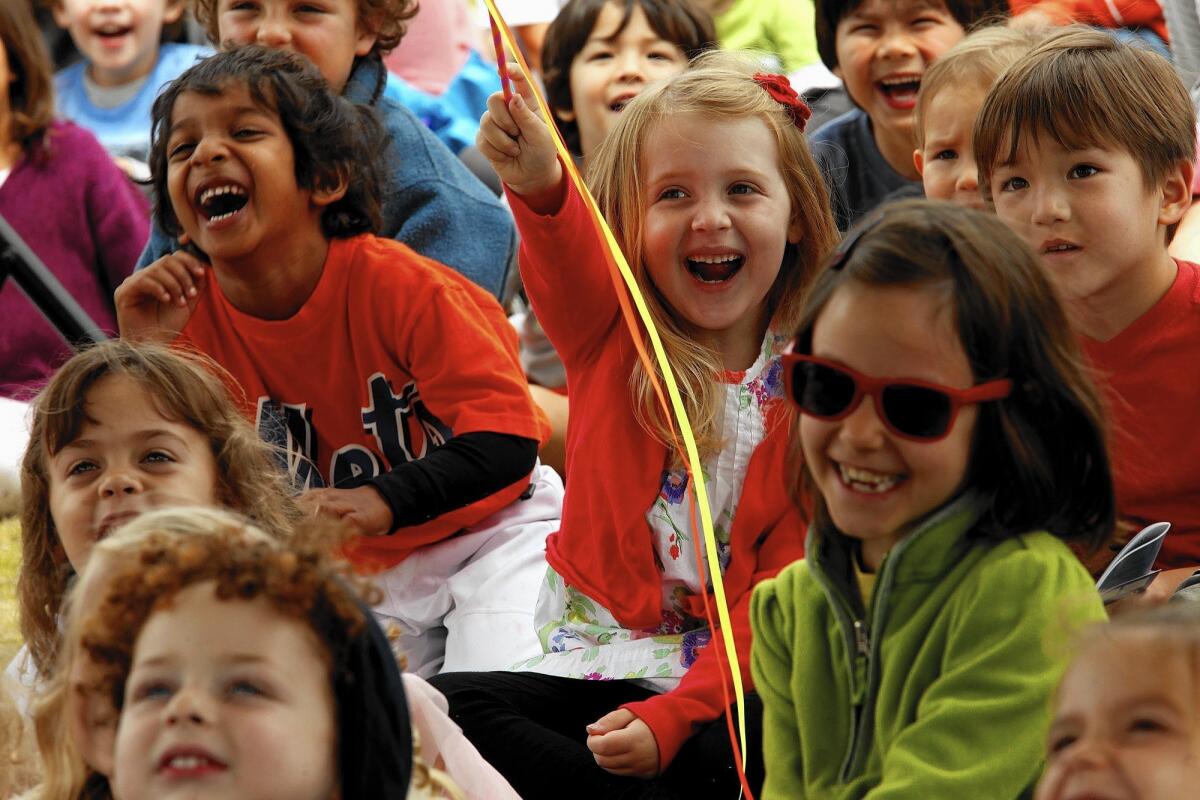Santa Monica found some surprises in creating well-being index

Santa Monica hosted an Arts and Literacy Festival on Saturday. The city could use results of a well-being study to identify groups not taking advantage of available services such as classes, libraries and other enrichment opportunities.
- Share via
Latching on to an idea that is catching fire with nations worldwide — including Bhutan, Britain, Chile and Canada — Santa Monica officials say their seaside enclave has created a groundbreaking analysis of its residents’ well-being, in hopes of using the results to improve their lives.
On Monday, the city of 90,000 will release the initial findings of a two-year effort to create a municipal well-being index.
The fledgling project has produced some sobering results for a city that sees itself as an exemplar of civic engagement.
Officials were surprised to find, for example, that many residents felt they had little influence on local decision-making.
That sense of detachment extends into people’s personal lives. Whereas 4 of 5 people nationally report having people around them that they can count on, only 56% of Santa Monicans feel that way. And 1 in 5 young people in Santa Monica reported feeling lonely all or most of the time.
“Many residents have told us there remains a sense of disconnection and lack of trust,” said Julie Rusk, the city’s assistant director of community and cultural services.
The well-being project was Santa Monica’s entry in Bloomberg Philanthropies’ first-ever Mayors Challenge, a nationwide competition to foster innovation in local government. In 2013, Santa Monica was named one of four runners-up and received $1 million in seed money to develop the venture.
City officials enlisted Rand Corp., a local think tank, and the London-based New Economics Foundation, along with a panel of researchers and practitioners in the young but growing field of well-being science.
James Anderson, head of government innovation at Bloomberg Philanthropies, described Santa Monica’s proposal as “a timely vision to better understand how its residents were faring.”
“This is an area of broad interest to cities, which are looking for increasingly sophisticated ways to measure and address needs in their communities,” he said. “Santa Monica is leading the way for others to follow.”
Throughout the world, more governments are using happiness data and research as they seek policies to enable people to live happier, more fulfilling lives. The United Nations last week issued its latest World Happiness Report, with Switzerland topping the cheerfulness list, followed by Iceland, Denmark, Norway and Canada. The United States ranked 15th.
Togo, Burundi, Benin and Rwanda — along with violence-wracked Syria — were the least happy nations.
The Santa Monica research team relied on three types of data. The first included quantifiable data that cities routinely collect on crime and disease rates, park acreage, education levels and use of transit services and libraries.
The city also conducted an online survey last fall to gather subjective information directly from residents about behaviors (such as sleep and exercise patterns) and experiences. Rusk said the issues of affordability, mobility and development were prominently on the minds of the 2,200 residents who responded.
Researchers also mined publicly available comments on social media such as Twitter and Foursquare that demonstrated people’s concerns about money, jobs and economic disparity.
Anita Chandra, a senior policy researcher at Rand who helped analyze the data, said Santa Monica’s venture is important, given that municipal governments are “reimagining how they work and support local residents.”
“Nothing like this has been done before,” Chandra said. “Other well-being efforts have mostly focused on the subjective experience alone and have not merged in city data with survey and social media information to capture a more holistic view of the well-being environment.”
One role of government is to serve as a safety net to ensure equity and access, she said, “but there’s also a role for government to partner with nonprofit groups to advance well-being.”
The city could use the results to identify groups that are not taking advantage of available services such as classes, libraries and other enrichment opportunities.
The city has already had some experience with using data to guide programs and services, with its ongoing Cradle to Career initiative. Researchers found that many 5-year-olds were not emotionally or intellectually ready for kindergarten. With the school district, the city recently began a kindergarten-readiness campaign.
Irma Carranza, a longtime community advocate, said she was excited about the possibilities of using the well-being results to help close the income gap by investing more in affordable housing. After graduating from college, her daughter could not afford to live in Santa Monica and moved to Studio City.
“Santa Monica prides itself on trying to keep diversity in the city,” she said. “We need to lessen the stressors.”
For more information about Santa Monica’s well-being report, see the city’s website.
Twitter: @MarthaGroves
More to Read
Sign up for Essential California
The most important California stories and recommendations in your inbox every morning.
You may occasionally receive promotional content from the Los Angeles Times.














